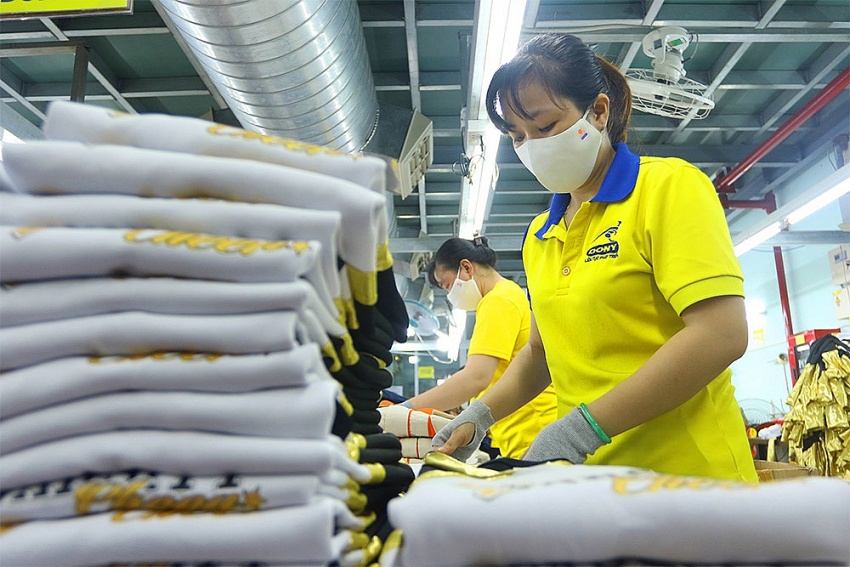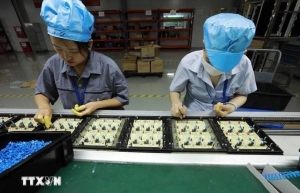More to do to ensure performance
Though the official figure for economic growth for Q2 will be released officially at the end of this week, fresh forecasts have been made, reflecting an uptrend in the economy.
 |
| More to do to ensure performance, illustration photo |
A research team at BIDV last week projected that Vietnam’s economic growth for Q2 will continue to be positive, likely to hit 5.9-6.3 per cent on-year – higher than the on-year 5.66 per cent rate recorded in Q1.
“The economy’s key impetuses such as exports, investment, and consumption are recovering strongly, though the levels of recovery are not the same,” said economic expert Can Van Luc, head of the team.
Figures from the General Statistics Office (GSO) showed that in the first five months of this year, Vietnam’s total export turnover reached an estimated $156.8 billion, up 15.2 per cent on-year. In May, the figure stood at an estimated $32.8 billion, up 15.8 per cent on-year.
Notably, the first five months also saw the total import turnover estimated to be $148.76 billion – up 18.2 per cent on-year. In which, nearly $55 billion was from Vietnamese companies (up 24.2 per cent), and $93.8 billion came from foreign-invested enterprises (up 15 per cent).
Though Vietnam suffered from a large trade deficit of $8.04 billion, it has reflected the fact that businesses in the country are recovering as they have to increase imports for their own production, given many types of items in the domestic markets have to be imported as they cannot be produced domestically.
According to the GSO, total five-month revenues from retail and consumption services touched more than $107.5 billion, up 8.7 per cent on-year. The increase rate in May hit 9.5 per cent on-year.
Meanwhile, when it comes to foreign direct investment (FDI), from January to May 20, the total newly registered capital, additional capital, and capital from stake acquisition and capital contribution reached $11.07 billion, up 2 per cent on-year. Newly registered capital stood at $7.94 billion for 1,230 projects – up 27.5 per cent on-year in the number of projects and up 50.8 per cent in capital.
The five-month disbursed capital reached $8.25 billion, up 7.8 per cent on-year.
“We are seeing the economy recovering,” said Prime Minister Pham Minh Chinh at the May cabinet meeting on Vietnam’s economy two weeks ago in Hanoi. “Enterprise confidence is on an uptrend, despite many difficulties lingering.”
Meanwhile, Singapore-based United Overseas Bank (UOB) two weeks ago released a projection that Vietnam’s GDP will climb 6 per cent in Q2 and for the entire year. The expected rate for next year will be 6.4 per cent. The optimistic forecasts are made based on the positive direction of economic activities.
FDI data in Vietnam is optimistic, indicating that investors continue to have confidence in Vietnam’s political environment and competitiveness, according to UOB.
The Ministry of Planning and Investment (MPI) has released its two newly updated economic growth scenarios a few weeks ago. Under the first scenario, the whole-year growth is expected to be 6 per cent – or the low level of the 6-6.5 per cent range set by the National Assembly (NA). To reach this 6 per cent rate, the average nine-month growth rate must be 6.12 per cent – including 5.85 per cent for Q2, 6.22 per cent for Q3, and 6.28 per cent for Q4.
Under the second scenario, the entire-year growth rate is projected to stand at 6.5 per cent – or the high level of the 6-6.5 per cent range set by the NA. To achieve this ambitious 6.5 per cent rate, the average nine-month economic growth rate must be about 6.75 per cent, including 6.32 per cent for Q2, 6.79 per cent for Q3, and 7.08 per cent for Q4.
“We believe that the economic performance may fall to the second scenario,” the MPI said. “However, big challenges remain. For example, many nations in the world have been implementing new economic stimulus packages, and this has and will cause pressure on the Vietnamese economy, which needs to recover more strongly and rapidly. Meanwhile, enterprises are facing numerous difficulties.”
The GSO reported that in the first five months of this year, the number of enterprises leaving the market reached 97,300, up 10 per cent on-year, while the number of newly established businesses sat at 64,800. About 19,500 enterprises were kicked out of the market every month.
In April, the World Bank released a projection that Vietnam’s economy is showing mixed signs of recovery, with growth forecast to reach 5.5 per cent in 2024 and gradually rise to 6 per cent by 2025.
“After experiencing a slowdown in 2023, the economy is showing mixed signs of recovery in early 2024. While exports are recovering, consumption and private domestic investment are growing more gradually,” said Dorsati Madani, senior economist at the World Bank in Vietnam.
According to the World Bank, real exports are expected to grow by 3.5 per cent in 2024, reflecting a gradual improvement in global demand. In addition, a turnaround in the real estate sector is anticipated later this year and next, bolstering domestic demand as investors and consumers regain confidence. Real total investment and private consumption are projected to increase by 5.5 per cent and 5 per cent in 2024, respectively.
PM Chinh has asked the MPI to coordinate with relevant ministries to propose large-scale preferential fiscal policies to support struggling enterprises, both aimed to spur on the economy’s traditional growth propellants, and also to fuel new economic drivers such as semiconductor and chip production, digital transformation, and AI. These policies must be reported in Q4.
 | Small business confidence high as Vietnam expects robust economic growth Small businesses in Vietnam are confident of a positive 2024, with 86 per cent projecting they will grow on the back of robust economic growth, improving on the previous two years, CPA Australia’s annual survey shows. |
 | Vietnam among six ASEAN countries with good economic growth: Maybank The gross domestic product (GDP) growth of six ASEAN countries - Indonesia, Malaysia, the Philippines, Singapore, Thailand and Vietnam - will recover to 4.5 per cent and 4.7 per cent in 2024 and 2025, respectively, from 4 per cent in 2023, according to Maybank Research Pte Ltd forecast. |
 | Media urged to improve for economy The media has been playing an active role in shaping a healthier business and investment climate, and supporting the government in formulating sound policies. |
What the stars mean:
★ Poor ★ ★ Promising ★★★ Good ★★★★ Very good ★★★★★ Exceptional
Related Contents
Latest News
More News
- Pivotal stage of growth paves way for rise in M&As (December 03, 2025 | 10:00)
- Positive projections for M&A interest from Thailand (December 03, 2025 | 09:40)
- Manifesting the first line of defence in cybersecurity (December 03, 2025 | 09:00)
- The transformational role AI can play in accounting arena (December 03, 2025 | 08:00)
- Unlocking 5G-AI potential in Singapore (December 03, 2025 | 08:00)
- Data-driven strategies vital for a fast-evolving nation (December 02, 2025 | 09:41)
- Policy to practice: how Vietnam can lead the region (November 26, 2025 | 16:03)
- Mobilising private capital at scale vital for climate battle (November 26, 2025 | 15:36)
- VILAF and Yoon & Yang launch Vietnam - Korea Practice Unit (November 26, 2025 | 15:16)
- Trademark disputes challenge foreign firms in Vietnam (November 24, 2025 | 15:30)

 Tag:
Tag:





















 Mobile Version
Mobile Version